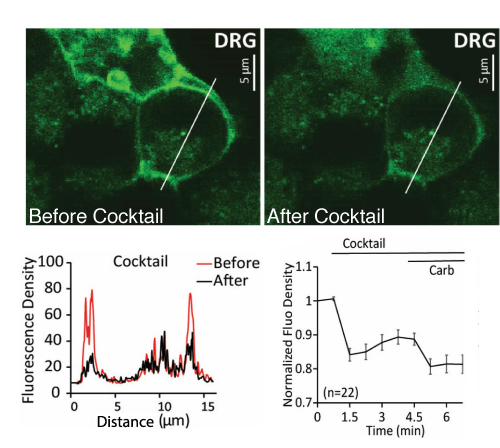PIP2 biosensor used in new research on the regulation of cold sensitivity in DRG neurons.
Summary:
A new article in the Journal of Neuroscience titled, “Gαq sensitizes TRPM8 to inhibition by PI(4,5)P2 depletion upon receptor activation”, graduate student Luyu Liu of Tibor Rohacs’ lab (rohacslab.org) at Rutgers Medical School and her colleagues explore how PIP2 levels, Ca2+, and the G-protein Gαq, converge to regulate activity of the cationic TRPM8 channel, which is normally activated by cold temperatures and chemical agonists such as menthol. In the manuscript the authors show results acquired using Montana Molecular’s green fluorescent biosensor for PIP2 in DRG neurons. DRG neurons are notoriously difficult to transfect, but Montana Molecular’s BacMam viral vectors efficiently delivered the sensor to the cells effectively overcoming the hurdle of difficult expression leading to a better understanding of the regulation of ion channels as they relate to the sensation of pain. Using the PIP2 biosensor along with Ca2+ monitoring and electrophysiology measurements the authors show how levels of the phospholipid PIP2 and direct binding of G-protein, Gαq, converge to inhibit activity of the TRPM8 channel. These results give us new insight into the regulation and sensitization of cold and pain sensation.
Key Findings
- Decreased PIP2 is important for Gq mediated inhibition of TRPM8 in DRG neurons.
- Gαq receptor activation decreased PIP2 and inhibited TRPM8 activity in DRG neurons.
- Gαq inhibits TRPM8 by reducing its apparent PIP2 affinity
Fig. 3: Liu, et al. BioRxiv. 2018.
Method Highlights
- Top: Images from Liu, et al. depicting DRG neurons transduced with Montana Molecular’s PIP2 biosensor before and after treatment with an inflammatory cocktail. The PIP2 biosensor was used to monitor membrane localized PIP2 levels in both DRG neurons and HEK293 cells
- Bottom Left: fluorescence density plotted across the line depicted in the images above show PIP2 localized to the plasma membrane. Bottom Right: average trace of PIP2 biosensor fluorescence before and after treatment with the inflammatory cocktail and addition of carbachol (Carb) as a positive control.
References
- L. Liu, et al. Gαq sensitizes TRPM8 to inhibition by PI(4,5)P2 depletion upon receptor activation. BioRxiv. 2018.
- Y. Ding, et al. Ratiometric biosensors based on dimerization dependent fluorescent protein exchange. Nature Methods. 2015.
- P. Tewson, et al. A Multiplexed Fluorescent Assay for Independent Second-Messenger Systems: Decoding GPCR Activation in Living Cells. J. Biomol. Screening, 2013.

